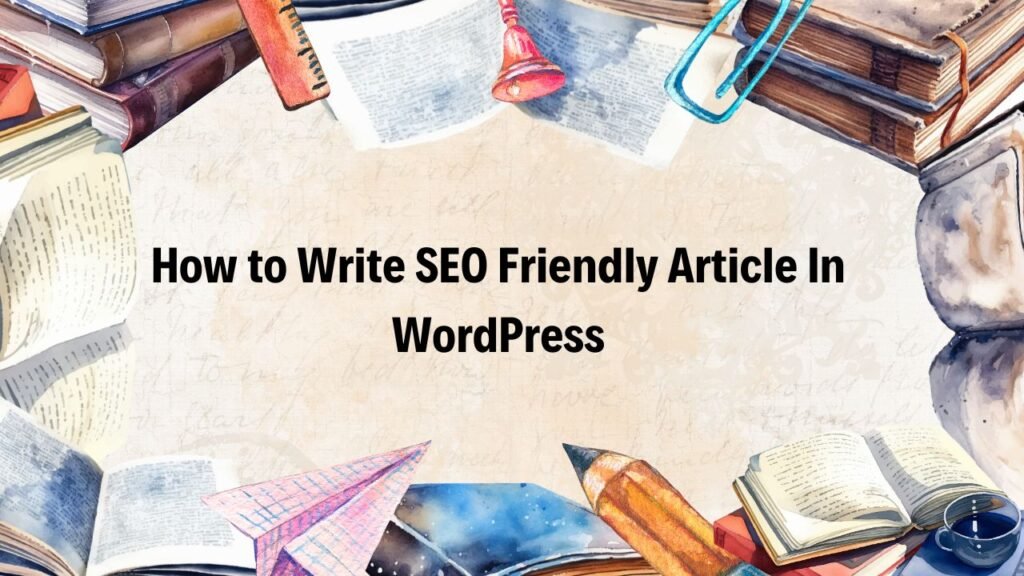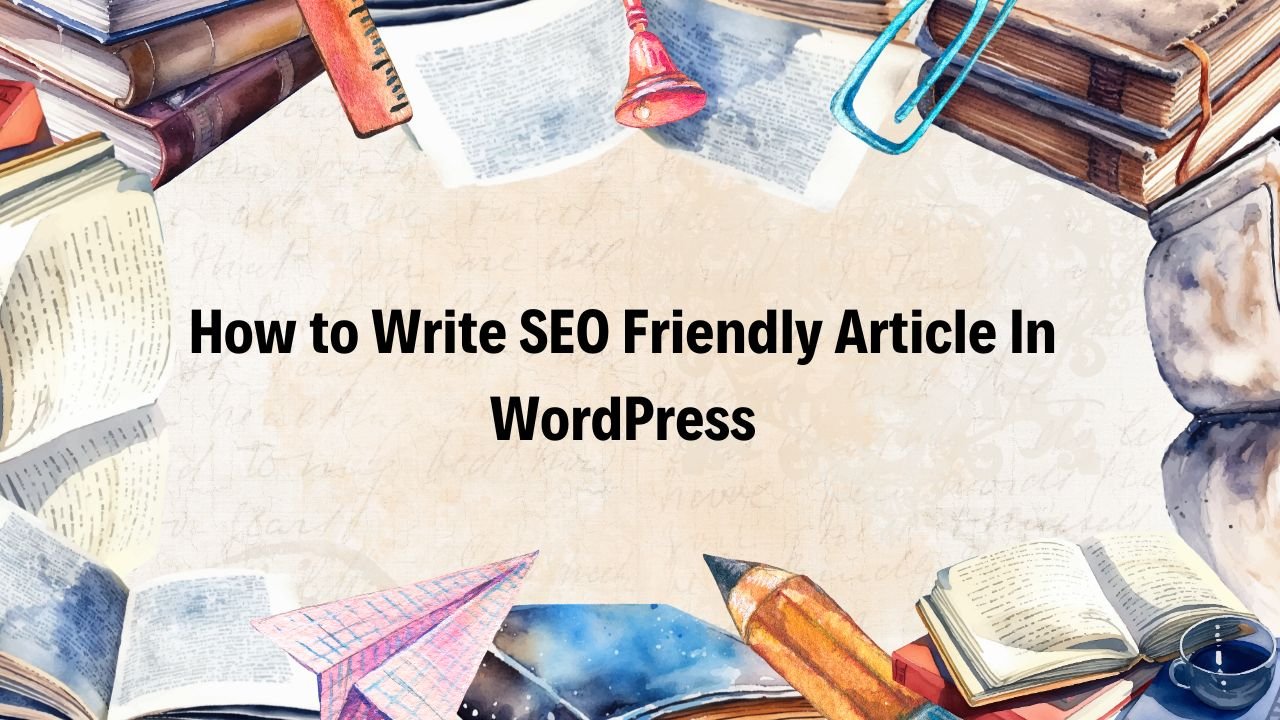In today’s digital landscape, creating content that ranks well on search engines is no longer optional—it’s essential. SEO-friendly content is the backbone of driving organic traffic to your website, increasing visibility, and ultimately achieving your online goals. Whether you’re a blogger, business owner, or content creator, understanding how to write SEO Friendly article In WordPress can make the difference between being lost in the vast sea of online content or standing out as a trusted authority.

WordPress, one of the most popular content management systems (CMS) in the world, is a powerhouse for creating SEO-friendly articles. Its user-friendly interface, combined with a wide range of plugins and tools, makes it easier than ever to optimize your content for search engines. But simply publishing on WordPress isn’t enough—you need to know how to leverage its features effectively to maximize your SEO potential.
In this article, you’ll learn step-by-step how to write SEO-friendly articles in WordPress. From conducting keyword research and crafting compelling titles to optimizing your content for readability and using powerful SEO plugins, we’ll cover everything you need to know. By the end, you’ll have actionable strategies to create content that not only ranks higher on Google but also provides real value to your readers. Let’s dive in and unlock the secrets to writing SEO-friendly articles that drive traffic and engagement!
1. Understand Your Audience and Goals
Before you even start writing, it’s crucial to understand who you’re writing for and what you want to achieve with your content. SEO isn’t just about pleasing search engines—it’s about creating content that resonates with your audience and fulfills their needs. After all, search engines prioritize content that provides value to users.
Why Knowing Your Audience Matters
Your target audience is the foundation of your content strategy. When you know who they are—their demographics, interests, pain points, and search behavior—you can create content that speaks directly to them. For example:
- Are they beginners looking for step-by-step guides?
- Are they professionals seeking in-depth analysis?
- Are they searching for quick solutions or detailed explanations?
By understanding your audience, you can tailor your tone, style, and content structure to meet their expectations. This not only improves user engagement but also increases the likelihood of your content ranking higher on search engines. How to write SEO friendly article In WordPress
Aligning Content with User Intent
User intent is the reason behind a search query. Google aims to deliver results that match what users are looking for, so your content must align with their intent. There are three main types of user intent:
- Informational Intent: Users want to learn something (e.g., “How to write SEO friendly article In WordPress”).
- Navigational Intent: Users are looking for a specific website or page (e.g., “WordPress login page”).
- Transactional Intent: Users are ready to take action (e.g., “buy SEO plugins for WordPress”).
To align your content with user intent:
- Analyze the top-ranking pages for your target keyword.
- Identify the type of content they’re providing (e.g., blog posts, product pages, videos).
- Ensure your content meets or exceeds what’s already available.
Defining Clear Goals for Your Article
Every piece of content should have a purpose. What do you want your article to achieve? Here are some common goals and tips to define them:
- To Inform: Provide valuable, educational content that answers your audience’s questions.
- To Entertain: Create engaging, shareable content that keeps readers hooked.
- To Convert: Include strong calls-to-action (CTAs) to encourage readers to sign up, buy, or contact you.
For example, if your goal is to inform, focus on creating detailed, well-researched content. If your goal is to convert, include persuasive CTAs and highlight the benefits of your product or service. How to write SEO friendly article In WordPress
Actionable Tips for Understanding Your Audience and Goals
- Create Audience Personas: Develop detailed profiles of your ideal readers, including their age, interests, and challenges.
- Use Analytics Tools: Tools like Google Analytics and Hotjar can help you understand your audience’s behavior and preferences.
- Conduct Surveys: Ask your audience directly what they want to read or learn about.
- Analyze Competitors: Study your competitors’ content to identify gaps and opportunities.
By understanding your audience and defining clear goals, you’ll create content that not only ranks well but also drives meaningful results. This is the first step toward how to write SEO Friendly article In WordPress that truly resonate with your readers.
2. Conduct Keyword Research
Keyword research is the cornerstone of any successful SEO strategy. It’s the process of identifying the words and phrases your target audience uses to search for information, products, or services online. Without proper keyword research, even the most well-written content risks getting lost in the vast expanse of the internet. By targeting the right keywords, you can attract qualified traffic, align your content with user intent, and improve your chances of ranking higher on search engines like Google—especially when writing SEO-friendly articles in WordPress. How to write SEO friendly article In WordPress
Why Keyword Research is Crucial for SEO
- Drives Targeted Traffic: Keywords act as a bridge between your content and your audience. They ensure your articles answer the questions users are actually asking.
- Improves Content Relevance: By targeting specific keywords, you signal to search engines what your content is about, boosting its visibility for relevant queries.
- Reduces Guesswork: Data-backed keyword research helps you create content that meets real user needs, rather than relying on assumptions. How to write SEO friendly article In WordPress
Top Tools for Keyword Research
Use these tools to uncover high-value keywords for your WordPress articles:
- Google Keyword Planner (Free): Ideal for beginners, this tool provides search volume and competition data for keywords.
- SEMrush (Paid): Offers advanced keyword analytics, competitor insights, and keyword difficulty scores.
- Ahrefs (Paid): Great for analyzing competitor keywords and discovering long-tail opportunities.
- Ubersuggest (Free/Paid): Provides keyword suggestions, search volume, and SEO difficulty ratings. How to write SEO friendly article In WordPress.
How to Choose the Right Keywords
1. Focus on Long-Tail Keywords
Long-tail keywords are longer, more specific phrases (e.g., “how to write SEO-friendly articles in WordPress” instead of “SEO tips”). They’re less competitive and often have higher conversion rates because they align closely with user intent.
- Example: Target “best WordPress plugins for SEO optimization” rather than “SEO plugins.”
2. Analyze Search Intent
Search intent refers to the goal behind a user’s query. Google prioritizes content that matches intent, so categorize keywords into these four types:
- Informational: Users want answers (e.g., “what is SEO”).
- Navigational: Users seek a specific site (e.g., “WordPress dashboard login”).
- Commercial: Users compare options (e.g., “Yoast SEO vs. Rank Math”).
- Transactional: Users ready to act (e.g., “buy WordPress SEO course”).
For example, if you’re writing about “how to write SEO-friendly articles in WordPress,” ensure your content provides a step-by-step guide (informational intent). How to write SEO friendly article In WordPress.
3. Evaluate Keyword Competition
Use tools like Ahrefs or SEMrush to check Keyword Difficulty (KD) scores. Aim for low-competition keywords (KD < 30) if your site is new, and gradually target tougher keywords as your domain authority grows.
4. Use LSI Keywords – How to Write SEO Friendly Article In WordPress
Latent Semantic Indexing (LSI) keywords are terms related to your primary keyword. They help search engines understand your content’s context and improve its relevance.
- Example: For “how to write SEO-friendly articles in WordPress,” LSI keywords might include “WordPress SEO plugins,” “on-page SEO tips,” or “optimize content for WordPress.”
- How to Find LSI Keywords: Use tools like LSIGraph, Google’s “People Also Ask” section, or the related searches at the bottom of SERPs.
Actionable Steps for Keyword Research in WordPress
- Start with Seed Keywords: Brainstorm broad topics related to your niche (e.g., “WordPress SEO”).
- Use Tools to Expand: Enter seed keywords into SEMrush or Ubersuggest to generate a list of long-tail variations.
- Filter by Intent and Competition: Prioritize keywords that match your content goals and have manageable competition.
- Map Keywords to Content: Assign primary and secondary keywords to each WordPress article to avoid cannibalization. How to write SEO friendly article In WordPress
By mastering keyword research, you’ll create content that not only ranks well but also addresses your audience’s needs—key to writing SEO-friendly articles in WordPress that drive traffic and engagement.
3. Craft a Compelling Title
Your article’s title is the first thing both readers and search engines see. It’s your chance to make a strong impression, attract clicks, and signal what your content is about. A well-crafted, SEO-optimized title can significantly improve your article’s visibility and click-through rate (CTR). When writing SEO-friendly articles in WordPress, your title plays a dual role: it must appeal to human readers while also satisfying search engine algorithms. How to write SEO friendly article In WordPress
Why a Click-Worthy, SEO-Optimized Title Matters
- Boosts CTR: A compelling title encourages users to click on your article in search results.
- Improves Rankings: Titles with primary keywords help search engines understand your content’s relevance.
- Sets Expectations: A clear, engaging title ensures readers know what to expect, reducing bounce rates. How to write SEO friendly article In WordPress
Tips for Writing SEO-Friendly Titles
1. Include Primary Keywords
Always incorporate your primary keyword near the beginning of the title. This helps search engines and users quickly identify the topic.
- Example: Instead of “A Guide to Writing Better Articles,” use “How to Write SEO-Friendly Articles in WordPress: A Step-by-Step Guide.”
2. Keep It Under 60 Characters
Search engines typically display the first 50–60 characters of a title. Keeping it concise ensures your full title appears in search results without being cut off. How to write SEO friendly article In WordPress
- Example: “10 Tips for Writing SEO-Friendly Articles in WordPress” (48 characters).
3. Use Power Words to Grab Attention
Power words evoke emotion or curiosity, making your title more enticing. Examples include:
- Action Words: “Master,” “Discover,” “Boost.”
- Emotional Words: “Essential,” “Proven,” “Ultimate.”
- Curiosity Words: “Secrets,” “Hacks,” “Strategies.”
- Example: “7 Proven Strategies to Write SEO-Friendly Articles in WordPress.”
4. Make It Specific and Benefit-Driven
Readers are more likely to click on titles that promise clear value or solutions. Highlight the benefits of reading your article. How to write SEO friendly article In WordPress
- Example: Instead of “WordPress SEO Tips,” use “How to Write SEO-Friendly Articles in WordPress: Boost Traffic in 2024.”
Examples of Good vs. Bad Titles
Bad Title: “SEO Tips for WordPress”
- Why It’s Bad: Too vague, lacks keywords, and doesn’t promise value.
Good Title: “How to Write SEO-Friendly Articles in WordPress: A Beginner’s Guide”
- Why It’s Good: Includes primary keywords, is specific, and appeals to beginners.
Bad Title: “Improve Your Website”
- Why It’s Bad: Generic, no keywords, and unclear.
Good Title: “10 Ways to Improve Your Website’s SEO with WordPress”
- Why It’s Good: Specific, includes keywords, and promises actionable tips.
How to Optimize Titles in WordPress
- Use SEO Plugins: Tools like Yoast SEO or Rank Math provide title optimization features, including character count and keyword placement checks.
- Avoid Duplicate Titles: Ensure each article has a unique title to prevent SEO issues.
- Test and Refine: Use A/B testing or analyze CTR data to see which titles perform best.
By crafting compelling, SEO-optimized titles, you’ll not only improve your rankings but also attract more readers to your WordPress articles. Remember, your title is the gateway to your content—make it count! How to write SEO friendly article In WordPress.
4. Structure Your Article for SEO
A well-structured article is not only easier to read but also more likely to rank well on search engines. Proper organization helps search engines understand your content’s hierarchy and relevance, while also improving the user experience. When writing SEO-friendly articles in WordPress, structuring your content effectively is a non-negotiable step. Let’s dive into how you can optimize your article’s structure for both readers and search engines.
1. Use Proper Heading Tags (H1, H2, H3, etc.)
Heading tags (H1, H2, H3, etc.) are essential for organizing your content and signaling its structure to search engines.
- H1: Reserved for the main title of your article (e.g., “How to Write SEO-Friendly Articles in WordPress”).
- H2: Used for main sections or subheadings (e.g., “Conduct Keyword Research”).
- H3: For subsections within H2s (e.g., “Tools for Keyword Research”).
Why It Matters:
- Improves readability by breaking content into digestible sections.
- Helps search engines understand the hierarchy and relevance of your content.
- Makes it easier for users to skim and find what they’re looking for.
Example:
H1: How to Write SEO-Friendly Articles in WordPress H2: Conduct Keyword Research H3: Tools for Keyword Research H3: How to Choose the Right Keywords H2: Craft a Compelling Title
2. Break Content into Short Paragraphs and Use Bullet Points
Large blocks of text can overwhelm readers and increase bounce rates. To keep your audience engaged:
- Use short paragraphs (2–3 sentences each).
- Incorporate bullet points or numbered lists for easy scanning.
- Add visuals like images, infographics, or videos to break up text.
Why It Matters:
- Improves readability and user experience.
- Keeps readers on your page longer, reducing bounce rates.
- Makes your content more shareable and engaging.
Example:
Instead of:
“Keyword research is important because it helps you understand what your audience is searching for and ensures your content aligns with their needs.”
Write:
“Keyword research is important because:
- It helps you understand your audience’s search behavior.
- Ensures your content aligns with their needs.
- Boosts your chances of ranking higher on search engines.”
3. Include Internal and External Links
Linking to other relevant content is a powerful SEO strategy. How to write SEO friendly article In WordPress.
- Internal Links: Point to other pages or articles on your website. This keeps readers engaged and helps search engines crawl your site more effectively.
- Example: Link to your previous article, “Top WordPress SEO Plugins for 2024.”
- External Links: Point to authoritative, high-quality websites. This adds credibility to your content and can improve your rankings.
- Example: Link to Google’s official guide on SEO best practices.
Why It Matters:
- Improves site navigation and user experience.
- Boosts your content’s authority and trustworthiness.
- Helps search engines understand the context of your content. How to write SEO friendly article In WordPress
4. Add a Table of Contents for Long-Form Articles
For long-form content (1,500+ words), a table of contents (TOC) is a must. It helps readers navigate your article and improves SEO by making your content more accessible.
- How to Add a TOC in WordPress: Use plugins like Easy Table of Contents or Rank Math’s TOC feature. These tools automatically generate a TOC based on your heading tags.
Why It Matters:
- Enhances user experience by allowing readers to jump to specific sections.
- Improves SEO by making your content more organized and crawlable.
- Increases the likelihood of earning featured snippets.
Example:
Table of Contents 1. Understand Your Audience and Goals 2. Conduct Keyword Research 3. Craft a Compelling Title 4. Structure Your Article for SEO 5. Optimize Your Content
Actionable Tips for Structuring Your Article
- Plan Before You Write: Outline your article with headings and subheadings before adding content.
- Use SEO Plugins: Tools like Yoast SEO or Rank Math can help you optimize headings and structure.
- Test Readability: Use tools like Hemingway Editor to ensure your content is easy to read.
- Update Old Content: Revisit older articles and improve their structure for better SEO performance.
5. Optimize Your Content
Optimizing your content is the final step in ensuring your article is SEO-friendly and ready to rank on search engines. From crafting a compelling meta description to strategically placing keywords and optimizing images, every detail matters. When writing SEO-friendly articles in WordPress, these optimizations not only improve your rankings but also enhance the user experience. Let’s break down how to optimize your content effectively.
1. Write a Meta Description with the Primary Keyword
The meta description is a short summary of your article that appears in search engine results. While it doesn’t directly impact rankings, it influences click-through rates (CTR).
- Best Practices:
- Keep it under 160 characters to avoid truncation.
- Include your primary keyword naturally (e.g., “how to write SEO-friendly articles in WordPress”).
- Make it compelling and action-oriented to encourage clicks.
Example:
“Learn how to write SEO-friendly articles in WordPress with this step-by-step guide. Discover tips for keyword research, on-page SEO, and optimizing content for better rankings.”
2. Use Keywords Naturally
Keywords are the backbone of SEO, but how you use them matters. Overloading your content with keywords (keyword stuffing) can hurt your rankings. Instead, focus on natural integration.
- Where to Place Keywords:
- First 100 Words: Include your primary keyword early to signal relevance.
- Headings: Use keywords in H2s and H3s to reinforce topic focus.
- Throughout the Article: Sprinkle keywords naturally, ensuring they fit contextually.
Example:
If your primary keyword is “how to write SEO-friendly articles in WordPress,” you might write:
“Writing SEO-friendly articles in WordPress requires a combination of keyword research, proper structuring, and on-page optimization. In this guide, we’ll walk you through the process step by step.”
3. Avoid Keyword Stuffing
Keyword stuffing is the practice of overusing keywords in an attempt to manipulate rankings. It not only harms readability but can also lead to penalties from search engines.
- How to Avoid It:
- Focus on user intent and write for your audience, not just search engines.
- Use synonyms and LSI (Latent Semantic Indexing) keywords to add variety.
- Aim for a keyword density of 1–2% (1–2 mentions per 100 words).
4. Optimize Images
Images make your content more engaging, but they can also slow down your site if not optimized properly.
- Use Descriptive File Names: Replace generic names like “IMG123.jpg” with descriptive ones like “write-seo-friendly-articles-wordpress.jpg.”
- Add Alt Text: Describe the image in a way that includes your primary keyword (if relevant).
- Example: Alt text for an image of a WordPress dashboard could be “WordPress dashboard for writing SEO-friendly articles.”
- Compress Images: Use plugins like Smush or ShortPixel to reduce file sizes without sacrificing quality.
5. Add a Call-to-Action (CTA)
A strong CTA encourages readers to take the next step, whether it’s leaving a comment, sharing your article, or exploring related content.
- Examples of CTAs:
- “Ready to start writing SEO-friendly articles in WordPress? Share your thoughts in the comments below!”
- “Loved this guide? Check out our post on the best WordPress SEO plugins for 2024.”
- “Subscribe to our newsletter for more tips on mastering WordPress SEO.”
Why It Matters:
- Increases user engagement and time spent on your site.
- Encourages social shares and backlinks, which boost SEO.
- Helps build a loyal audience.
Actionable Tips for Optimizing Your Content
- Use SEO Plugins: Tools like Yoast SEO or Rank Math can help you optimize meta descriptions, keywords, and readability.
- Test Your Meta Description: Use SERP simulators to see how your meta description will appear in search results.
- Audit Your Content: Regularly review older articles and update them with optimized keywords, meta descriptions, and CTAs.
- Monitor Performance: Use Google Analytics and Search Console to track how your optimized content performs.
6. Improve Readability
Readability is a critical factor in creating SEO-friendly articles that engage readers and keep them on your page. Search engines like Google prioritize content that is easy to read and understand, as it aligns with their goal of providing the best user experience. When writing SEO-friendly articles in WordPress, improving readability ensures your content appeals to both search engines and your audience. Let’s explore how to make your articles more readable and user-friendly.
1. Write in a Conversational Tone
A conversational tone makes your content feel approachable and relatable, encouraging readers to stay engaged.
- Why It Matters:
- Builds trust and connection with your audience.
- Makes complex topics easier to understand.
- Keeps readers interested and reduces bounce rates.
- How to Do It:
- Write as if you’re speaking directly to the reader.
- Use contractions (e.g., “you’ll” instead of “you will”).
- Avoid overly formal or technical language unless necessary.
Example:
Instead of: “It is imperative that one utilizes keywords in a strategic manner.”
Write: “You’ll want to use keywords strategically to boost your rankings.”
2. Use Short Sentences and Simple Language
Long, complex sentences can confuse readers and make your content harder to follow. Simplifying your language improves comprehension and keeps readers engaged.
- Why It Matters:
- Makes your content accessible to a wider audience.
- Reduces cognitive load, making it easier for readers to absorb information.
- Improves your chances of ranking for featured snippets.
- How to Do It:
- Aim for sentences with 15–20 words or fewer.
- Break long sentences into shorter ones.
- Use simple words instead of jargon (e.g., “use” instead of “utilize”).
Example:
Instead of: “In order to optimize your content for search engines, it is essential to conduct thorough keyword research and implement on-page SEO strategies.”
Write: “To optimize your content, start with keyword research and use on-page SEO strategies.”
3. Use Tools to Check Readability
Several tools can help you analyze and improve the readability of your content:
- Yoast SEO: This popular WordPress plugin provides a readability analysis, highlighting areas for improvement like sentence length and passive voice.
- Hemingway Editor: A free tool that grades your content’s readability and suggests simplifications.
- Grammarly: Helps you refine your writing for clarity and tone.
Why It Matters:
- These tools provide actionable feedback to improve your content.
- They help you meet SEO best practices for readability.
4. Aim for a Flesch Reading Ease Score of 60 or Higher
The Flesch Reading Ease score is a metric that measures how easy your content is to read. Scores range from 0 (hard to read) to 100 (very easy).
- Why It Matters:
- Content with a score of 60 or higher is considered easy to read and is more likely to engage readers.
- Search engines favor content that is accessible to a broad audience.
- How to Improve Your Score:
- Use shorter sentences and paragraphs.
- Simplify complex words and phrases.
- Avoid excessive use of passive voice.
Example:
A sentence like “The utilization of keywords is of paramount importance for SEO” has a low readability score.
Rewriting it as “Using keywords is key for SEO” improves readability.
Actionable Tips for Improving Readability
- Write for Your Audience: Tailor your tone and language to match your readers’ knowledge level.
- Break Up Text: Use headings, bullet points, and visuals to make your content scannable.
- Read Aloud: If a sentence sounds awkward when spoken, rewrite it.
- Test Your Content: Use tools like Yoast SEO or Hemingway Editor to identify and fix readability issues.
By improving readability, you’ll create content that not only ranks well but also resonates with your audience. This is a key step in writing SEO-friendly articles in WordPress that drive traffic, engagement, and conversions.
7. Use SEO Plugins for WordPress
SEO plugins are essential tools for optimizing your WordPress articles and ensuring they rank well on search engines. These plugins simplify the process of on-page SEO, making it easier for beginners and experts alike to create SEO-friendly content. When writing SEO-friendly articles in WordPress, leveraging the right plugins can save you time and improve your results. Let’s explore the top SEO plugins and how to use them effectively.
Recommended Plugins
1. Yoast SEO
Yoast SEO is one of the most popular WordPress plugins, offering a comprehensive suite of tools for on-page optimization.
- Key Features:
- Focus keyword analysis.
- Readability and SEO scoring.
- XML sitemap generation.
- Meta title and description optimization.
2. Rank Math
Rank Math is a powerful alternative to Yoast SEO, known for its user-friendly interface and advanced features.
- Key Features:
- Advanced keyword optimization.
- Schema markup integration.
- Content AI for topic suggestions.
- Built-in redirection manager.
3. All in One SEO Pack
All in One SEO Pack is a beginner-friendly plugin that simplifies SEO optimization.
- Key Features:
- Easy setup wizard.
- XML sitemap support.
- Google Analytics integration.
- Basic on-page SEO tools.
How to Use These Plugins to Optimize Your Article
1. Set Focus Keywords
Focus keywords are the primary terms you want your article to rank for. Both Yoast SEO and Rank Math allow you to set a focus keyword and analyze how well your content aligns with it.
- Steps:
- Enter your focus keyword (e.g., “how to write SEO-friendly articles in WordPress”).
- Follow the plugin’s suggestions to optimize your content, such as adding the keyword to your title, meta description, and headings.
Why It Matters:
- Helps search engines understand your content’s relevance.
- Ensures your article targets the right audience.
2. Analyze Readability and SEO Scores
Readability and SEO scores provide actionable feedback to improve your content.
- Readability Analysis:
- Checks sentence length, paragraph structure, and use of transition words.
- Ensures your content is easy to read and understand.
- SEO Analysis:
- Evaluates keyword usage, meta descriptions, and internal linking.
- Provides tips to improve your article’s SEO performance.
Example:
If Yoast SEO suggests your sentence length is too long, break it into shorter sentences. If Rank Math flags a missing meta description, add one that includes your focus keyword.
3. Generate XML Sitemaps
An XML sitemap is a file that lists all the pages on your website, helping search engines crawl and index your content.
- How to Generate:
- In Yoast SEO: Go to General > Features and enable the XML sitemap option.
- In Rank Math: Navigate to Dashboard > Sitemap Settings and enable the sitemap feature.
- In All in One SEO Pack: Go to XML Sitemap and enable the sitemap generator.
Why It Matters:
- Improves your site’s visibility to search engines.
- Ensures new content is indexed quickly.
Actionable Tips for Using SEO Plugins
- Install Only One Plugin: Using multiple SEO plugins can cause conflicts. Choose one that best fits your needs.
- Follow Plugin Recommendations: Implement the suggestions provided by the plugin to improve your content.
- Regularly Update Plugins: Keep your plugins updated to access the latest features and security patches.
- Monitor Performance: Use the plugin’s analytics tools to track your content’s performance and make adjustments as needed.
8. Optimize for Mobile and Speed
In today’s digital world, mobile-friendliness and page speed are critical factors for both user experience and SEO. With over half of all web traffic coming from mobile devices, ensuring your WordPress articles are optimized for mobile and load quickly is essential. When writing SEO-friendly articles in WordPress, these optimizations not only improve your rankings but also keep readers engaged and reduce bounce rates. Let’s explore how to make your content mobile-friendly and fast-loading.
1. Ensure Your Article is Mobile-Friendly
Mobile-friendliness is a key ranking factor for Google, and it directly impacts how users interact with your content.
- Why It Matters:
- Over 60% of web traffic comes from mobile devices.
- Google uses mobile-first indexing, meaning it primarily uses the mobile version of your site for ranking.
- A poor mobile experience can lead to higher bounce rates and lower engagement.
- How to Check Mobile-Friendliness:
- Use Google’s Mobile-Friendly Test tool to analyze your article’s mobile compatibility.
- Test your article on different devices (smartphones, tablets) to ensure it displays correctly.
- How to Improve Mobile-Friendliness:
- Use a responsive WordPress theme (see next section).
- Avoid large, unoptimized images that slow down loading times.
- Ensure buttons and links are easy to tap on smaller screens.
2. Use a Responsive WordPress Theme
A responsive theme automatically adjusts your content to fit different screen sizes, ensuring a seamless experience across devices.
- Why It Matters:
- Improves user experience on mobile devices.
- Boosts SEO by meeting Google’s mobile-first indexing requirements.
- Saves time by eliminating the need for a separate mobile site.
- Recommended Responsive Themes:
- Astra: Lightweight and highly customizable.
- GeneratePress: Fast and SEO-friendly.
- Neve: Designed for speed and performance.
- How to Check if Your Theme is Responsive:
- Resize your browser window and see if the content adjusts smoothly.
- Use tools like Responsive Design Checker to test your theme on various devices.
3. Optimize Page Speed with Caching Plugins
Page speed is another critical ranking factor. Slow-loading pages frustrate users and increase bounce rates.
- Why It Matters:
- Faster pages improve user experience and engagement.
- Google prioritizes fast-loading sites in search rankings.
- A one-second delay in page load time can reduce conversions by 7%.
- How to Improve Page Speed:
- Use Caching Plugins:
- WP Rocket: A premium plugin that simplifies caching and improves speed.
- W3 Total Cache: A free plugin with advanced caching features.
- LiteSpeed Cache: Optimized for LiteSpeed servers, offering powerful caching options.
- Compress Images: Use plugins like Smush or ShortPixel to reduce image file sizes.
- Minify CSS and JavaScript: Use plugins like Autoptimize to combine and minify code.
- Enable Lazy Loading: Delay loading images until they’re needed (supported by many caching plugins).
- Use Caching Plugins:
- How to Test Page Speed:
- Use tools like Google PageSpeed Insights or GTmetrix to analyze your site’s performance.
- Follow the recommendations provided by these tools to improve speed.
Actionable Tips for Mobile and Speed Optimization
- Choose a Lightweight Theme: Avoid bloated themes with unnecessary features.
- Optimize for Core Web Vitals: Focus on metrics like Largest Contentful Paint (LCP), First Input Delay (FID), and Cumulative Layout Shift (CLS).
- Use a Content Delivery Network (CDN): Services like Cloudflare or StackPath can speed up content delivery globally.
- Regularly Monitor Performance: Use tools like Google Search Console to track mobile usability and page speed over time.
9. Promote Your Article
Writing an SEO-friendly article in WordPress is only half the battle—promoting it effectively is equally important. Even the best content won’t drive traffic or rankings if no one knows it exists. By actively promoting your article, you can increase its visibility, attract more readers, and build valuable backlinks. Let’s explore actionable strategies to promote your WordPress articles and maximize their impact.
Social media is a powerful tool for driving traffic to your WordPress articles. By sharing your content on platforms like Facebook, Twitter, LinkedIn, and Instagram, you can reach a wider audience and encourage engagement.
- Why It Matters:
- Increases visibility and drives immediate traffic.
- Encourages social shares, which can indirectly boost SEO.
- Builds a loyal following for your brand or blog.
- How to Do It Effectively:
- Use eye-catching visuals (e.g., custom graphics or featured images).
- Write engaging captions with relevant hashtags.
- Share your article multiple times, especially on platforms like Twitter, where posts have a short lifespan.
- Join niche-specific groups or communities (e.g., Facebook groups or LinkedIn forums) and share your article where relevant.
Example:
If your article is about “how to write SEO-friendly articles in WordPress,” you could share it in SEO or WordPress-related groups with a caption like:
“Struggling to write SEO-friendly articles in WordPress? Check out this step-by-step guide to boost your rankings and drive more traffic! 🚀 #SEO #WordPress #ContentMarketing”
2. Use Email Marketing to Reach Your Subscribers
Email marketing is a highly effective way to promote your content directly to your audience.
- Why It Matters:
- Reaches readers who are already interested in your content.
- Drives consistent traffic to your articles.
- Encourages repeat visits and builds loyalty.
- How to Do It Effectively:
- Send a newsletter featuring your latest article.
- Use a compelling subject line (e.g., “Master SEO-Friendly Writing in WordPress with These Tips!”).
- Include a brief summary and a clear call-to-action (CTA) to read the full article.
- Segment your email list to target specific audiences with relevant content.
Example:
Subject Line: “🚀 New Post: How to Write SEO-Friendly Articles in WordPress”
Email Body: “Hi [Name], I just published a new guide on writing SEO-friendly articles in WordPress. Learn how to optimize your content for better rankings and traffic. Check it out here: [Link]”
3. Engage with Your Audience in the Comments Section
Engaging with readers in the comments section of your article can boost user interaction and encourage repeat visits.
- Why It Matters:
- Builds a sense of community around your content.
- Increases time spent on your site, which can improve SEO.
- Encourages readers to share your article with others.
- How to Do It Effectively:
- Respond to comments promptly and thoughtfully.
- Ask questions to encourage further discussion (e.g., “What’s your biggest challenge with WordPress SEO?”).
- Thank readers for their feedback and suggestions.
Example:
If a reader comments, “Great tips! I didn’t know about LSI keywords,” you could reply:
“Thanks for reading! LSI keywords are a game-changer for SEO. Let me know if you have any questions while implementing them!”
4. Build Backlinks by Reaching Out to Influencers or Guest Posting
Backlinks are one of the most important ranking factors for SEO. By building high-quality backlinks, you can improve your article’s authority and visibility.
- Why It Matters:
- Increases your site’s domain authority.
- Drives referral traffic from other websites.
- Signals to search engines that your content is valuable and trustworthy.
- How to Do It Effectively:
- Reach Out to Influencers: Share your article with influencers in your niche and ask them to link to it if they find it useful.
- Guest Posting: Write guest articles for reputable blogs in your industry and include a link back to your WordPress article.
- Broken Link Building: Find broken links on other websites and suggest your article as a replacement.
Example:
If you’ve written an article on “how to write SEO-friendly articles in WordPress,” you could pitch it to a marketing blog like this:
“Hi [Name], I noticed your article on [Topic] includes a broken link. I recently published a guide on writing SEO-friendly articles in WordPress that might be a great replacement. Let me know if you’d like to check it out!”
Actionable Tips for Promoting Your Article
- Schedule Social Media Posts: Use tools like Buffer or Hootsuite to automate your social media sharing.
- Repurpose Content: Turn your article into a video, infographic, or podcast to reach different audiences.
- Collaborate with Others: Partner with other bloggers or influencers to co-promote each other’s content.
- Track Performance: Use tools like Google Analytics to monitor traffic from your promotion efforts and adjust your strategy as needed.
10. Monitor and Update Your Content
Creating an SEO-friendly article in WordPress is not a one-time task—it’s an ongoing process. To maintain and improve your rankings, you need to regularly monitor your content’s performance and make updates as needed. Search engines favor fresh, relevant, and accurate content, so keeping your articles up-to-date is crucial for long-term SEO success. Let’s dive into how you can effectively monitor and update your content to stay ahead of the competition.
1. Use Tools Like Google Analytics and Google Search Console to Track Performance
Tracking your content’s performance helps you understand what’s working and what needs improvement.
- Google Analytics:
- What It Does: Tracks traffic, user behavior, and conversions.
- Key Metrics to Monitor:
- Pageviews: How many people are reading your article?
- Bounce Rate: Are readers leaving your site quickly?
- Average Session Duration: How long are readers staying on your page?
- Traffic Sources: Where is your traffic coming from (e.g., organic search, social media)?
- Google Search Console:
- What It Does: Provides insights into your site’s search performance.
- Key Metrics to Monitor:
- Impressions: How often your article appears in search results.
- Click-Through Rate (CTR): The percentage of users who click on your article in search results.
- Keyword Rankings: Which keywords your article is ranking for.
- Indexing Issues: Are there any problems preventing your article from being indexed?
Why It Matters:
- Helps you identify high-performing content and replicate its success.
- Reveals opportunities to improve underperforming articles.
- Provides data-driven insights for future content strategies.
2. Update Old Articles with New Information and Keywords
Search engines prioritize fresh, relevant content. Regularly updating your articles ensures they remain accurate and competitive.
- Why It Matters:
- Improves rankings by signaling to search engines that your content is up-to-date.
- Keeps readers engaged with accurate and relevant information.
- Allows you to target new keywords and trends.
- How to Update Effectively:
- Refresh Statistics and Data: Replace outdated information with the latest data.
- Add New Keywords: Incorporate trending or high-performing keywords.
- Expand Content: Add new sections, examples, or case studies to provide more value.
- Improve Readability: Simplify complex sentences, add bullet points, or include visuals.
Example:
If you wrote an article two years ago titled “How to Write SEO-Friendly Articles in WordPress,” you could:
- Update it with the latest WordPress SEO plugins.
- Add new tips based on recent algorithm changes.
- Include a section on Core Web Vitals and their impact on SEO.
3. Regularly Check for Broken Links and Fix Them
Broken links (links that lead to non-existent pages) harm user experience and SEO.
- Why It Matters:
- Broken links frustrate users and increase bounce rates.
- Search engines penalize sites with too many broken links.
- Fixing broken links improves site authority and user trust.
- How to Find and Fix Broken Links:
- Use Tools: Plugins like Broken Link Checker or tools like Ahrefs can identify broken links.
- Update or Remove Links: Replace broken links with working ones or remove them entirely.
- Redirect Broken URLs: Use a redirection plugin (e.g., Redirection) to redirect broken links to relevant pages.
Example:
If a link to a WordPress plugin in your article no longer works, replace it with a link to the updated plugin page or a suitable alternative.
Actionable Tips for Monitoring and Updating Content
- Set a Schedule: Regularly review your content (e.g., every 3–6 months) to ensure it stays relevant.
- Track Competitors: Monitor what your competitors are doing and update your content to stay competitive.
- Engage with Readers: Use comments and feedback to identify areas for improvement.
- Use Plugins: Tools like Yoast SEO or Rank Math can help you track content performance and identify issues.
Conclusion
Writing SEO-friendly articles in WordPress is a skill that combines creativity with technical know-how. By following the steps outlined in this guide—conducting thorough keyword research, structuring your content for readability, optimizing on-page elements, and actively promoting your articles—you’ll create content that not only ranks well but also resonates with your audience. Remember, SEO is not a one-time task but an ongoing process. Regularly monitoring performance and updating your content ensures it stays relevant and competitive.
Now that you’ve learned how to write SEO-friendly articles in WordPress, it’s time to put these strategies into action. Start by implementing one tip at a time, track your results, and refine your approach.
📣 Your Turn!
Have questions about optimizing your WordPress content? Or success stories to share? Drop a comment below—we’d love to hear from you!
FAQs
1. What is the best WordPress plugin for SEO?
Answer:
Yoast SEO and Rank Math are two of the most popular and effective plugins for optimizing WordPress content.
- Yoast SEO: Offers robust features like readability analysis, meta title/description optimization, and XML sitemap generation. Ideal for beginners and advanced users alike.
- Rank Math: Known for its advanced schema markup, keyword tracking, and AI-driven content suggestions.
Both plugins simplify on-page SEO and are essential for writing SEO-friendly articles in WordPress.
2. How often should I update my content for SEO?
Answer:
Regular updates are key to maintaining SEO performance. Here’s when to refresh your content:
- When rankings drop: Use tools like Google Search Console to identify declining keywords.
- When information becomes outdated: Update statistics, trends, or tools (e.g., new WordPress SEO plugins).
- Seasonally: Refresh content related to holidays, events, or annual trends.
Aim to audit your content every 3–6 months to keep it accurate and competitive.
3. Can I write SEO-friendly content without plugins?
Answer:
Yes, but it requires manual effort. Here’s how:
- Manually add meta titles/descriptions: Use WordPress’s built-in editor.
- Optimize headings and keywords: Follow SEO best practices for keyword placement and structure.
- Compress images: Use free tools like TinyPNG before uploading.
While plugins like Yoast SEO or Rank Math streamline the process, consistency and attention to detail can still yield strong results.








